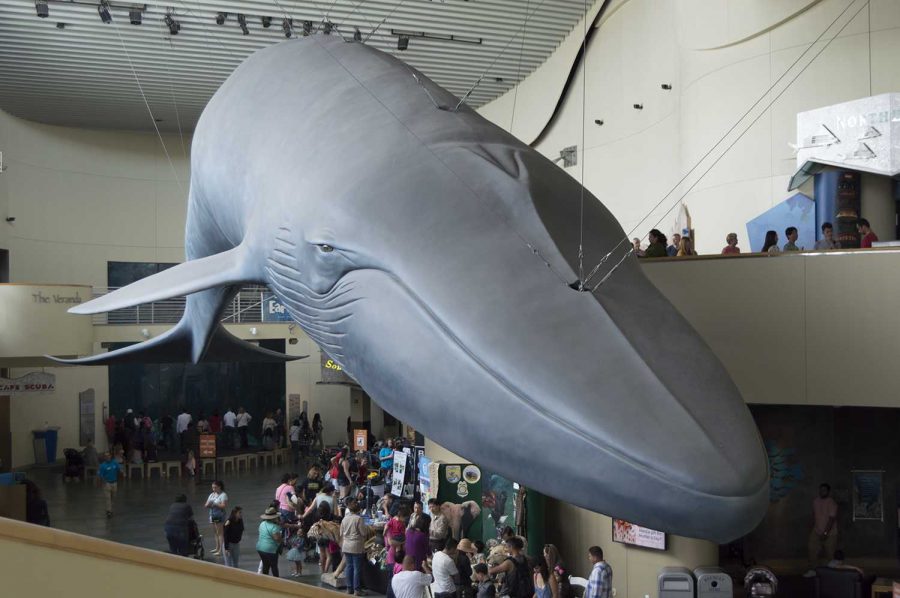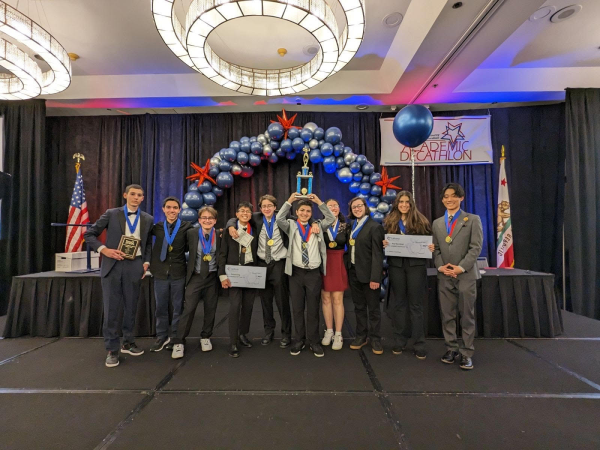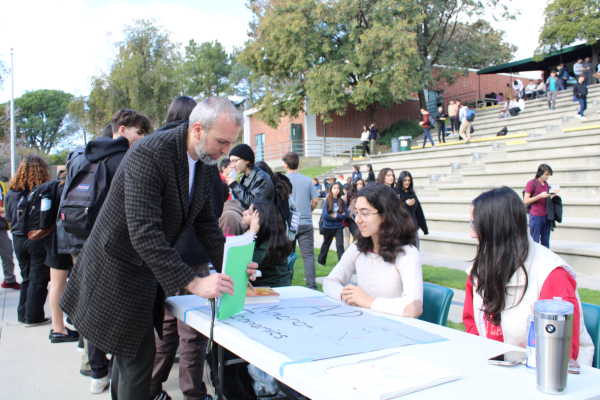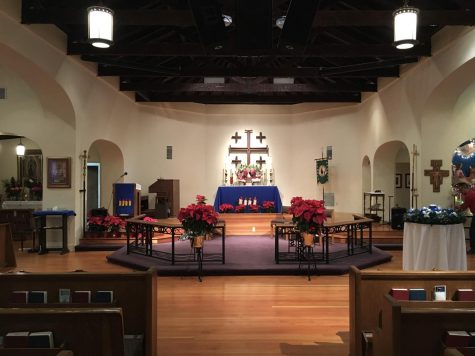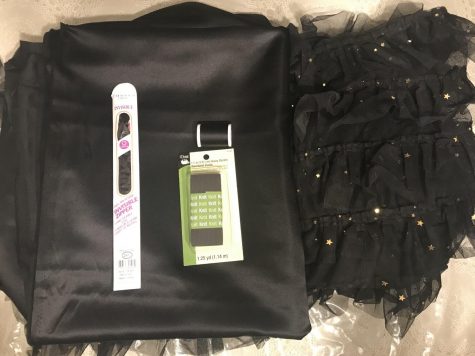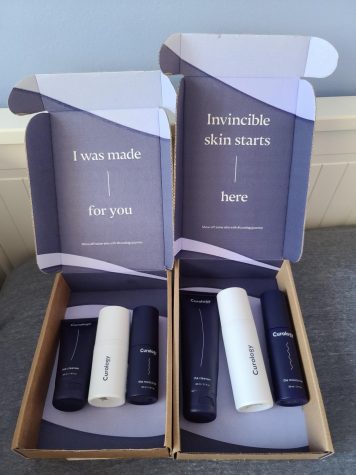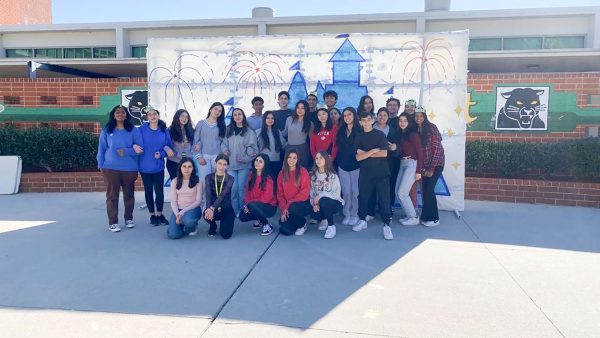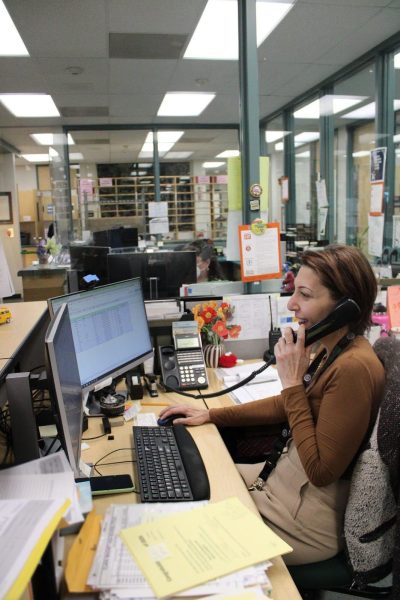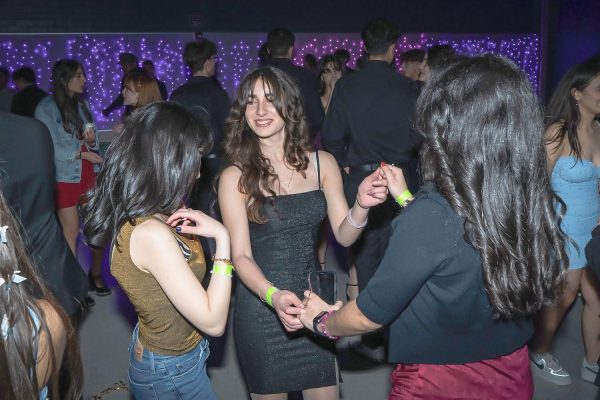Earth Day weekend at the Aquarium of the Pacific
Representing Clark Magnet’s GIS Program
The life-size blue whale sculpture in the aquarium’s main lobby.
The Aquarium of the Pacific has always been a special place for children, their families and the environmentally savvy. Earth Day is certainly not an insignificant time at the aquarium nor around the world, with more than 192 countries in participation. This festival brings institutions together with the common goal of getting the word out about how the environment is important. Whether by advocating recycling, conservation of energy, or alternative energy resources, those celebrating Earth Day have successfully educated many people around the world about environmental issues.
On April 23 and 24, the aquarium’s 16th annual event was held, where organizations showed off their work to save the environment. Representing the Scientific Research class and personally going to the aquarium for the first time, senior James Rivera and I were the first students ever staffing a booth from Clark Magnet.
“It seemed like a great idea,” Rivera said. “It’s not every day that you get to present at the Aquarium of the Pacific with the professionals.” Rivera was accompanied by two other friends whom he had known from the ArcGIS class in previous years.
Before the event, we didn’t know what we were expected to do. Our instructions were very vague. “Just show up to the aquarium and at the entrance tell them you’re from Clark Magnet High School,” said teacher Dominique Evans-Bye. “Your admission will be covered. All you have to do there is stand at the booth and tell them about your experience in the Scientific Research class.”
To me, telling the volunteers working there that I’m from Clark Magnet seemed like some kind of secret code for free admission. In reality, everyone presenting that weekend would receive a complimentary ticket for each day they were to attend. Family and friends, however, would have to pay the normal price (discounted for bringing an electronic appliance for recycling).
After the hour-long drive to Long Beach on that Saturday, I arrived at the aquarium only to see masses of people in line purchasing tickets. This was when I started getting nervous about presenting.
I finally made my way inside and was amazed to see hanging above me in the lobby a life-sized sculpture of a blue whale with its calf. I then walked down to the other side of the lobby where the booth of the Bureau of Ocean Energy Management (BOEM) was located. BOEM was one of the Earth-friendly organizations organization giving visitors hands-on learning experiences. BOEM is the part of the U.S. Department of the Interior that is responsible for managing the nation’s offshore resources in an environmentally and economically safe way.
That is where I was greeted by Evans-Bye as well as employees of BOEM. This was a relief, as I then knew I was not going to be alone talking to the many people at this aquarium.

Two boys take control of the ROV at the mobile terminal display.
“Great, you’re here,” Evans-Bye said. “All you need to do is stand here and explain to people what you do in the class. Talk about how we won the Lexus Eco Challenge, how we’re DNA barcoding, or even how we use ArcGIS mapping software programs. Make sure you keep yourself looking approachable — get people interested in what we have to say.”
Our display was mostly provided by BOEM and included a large background poster for their organization as well as flyers, posters and a television display of footage from their field work. From Clark, we provided a Remote Operated Vehicle (ROV), which is our eyes underwater. The ROV is a miniature submarine that has a camera on the front, a flashlight, a manipulating arm, and is hooked to a cable that plugs into a computer. We use the computer as the control panel where we can see live camera footage as well as take snapshots or record video underwater. The ROV is not piloted from the computer but is navigated by a much smaller handheld remote which elevation controls, a joystick for steering, and buttons to utilize the flashlight, camera and the arm. All these functions in a yellow machine that takes up no more than 2 square feet on a table is what really captivated the passerbys, especially small children.
“What is that?” a small child asked me. I answered, saying that this is the type of machine divers use to take videos of the fish in the water for nature shows. I tried to give him the simple rundown, as the previous explanation would probably have him turn and run away. As with all the children, the BOEM employees gave the boy a sticker of his choice of ocean animals and fish.
Later, a man much older than the small child asked me a similar question. “What’s that?” the man asked. I gave the same explanation as I did to the little boy and the many children before the man. This answer proved to be a lot quicker and still gave the viewer the general idea. After the explanation I asked him if he had any questions about the display. “No,” he said. “Actually, I know all about this. I’m a diver myself. Usually I’m the one who has to dive down and retrieve that sucker if something goes wrong with its system.” The man essentially gave Rivera and me a pop quiz on our display. I then smiled and bid him good-bye as he went on to see the rest of the aquarium. “At first I felt that there was something odd about that man,” Rivera said. “After he left I had let out a nervous laugh to try to ease the tension.”

The BOEM booth showcasing the ROV and other visual displays.
After this, I realized that the people coming to the aquarium that weekend had a broad understanding of the environment and the ways groups put in the effort to help it. Some had more knowledge than others, but, because of this event, I was able to do my part to help save the earth by trying to educate others (even the little children).
It was now time to go home and rest, but only after hours of grueling bumper-to-bumper California freeway traffic. After everything that had happened during this weekend, I was able to meet some interesting people at the aquarium — children and adults, even though I had ulterior motives like community service hours and extra credit.

INTERESTS/HOBBIES: Music and Computer games.
EXTRACURRICULAR ACTIVITIES: Going to amusement parks and Movies with friends.
THREE WORDS TO DESCRIBE...



